Ring type Displacement Transducer
OU Ring type Displacement Transducer
10mm to 30mm
The OU displacement transducer is a combination of a round plate spring and strain gauges. It is mounted with its contact tip pressed against a structure. When displacement occurs in the structure, the plate spring is deformed and an output proportional to the displacement can be output.
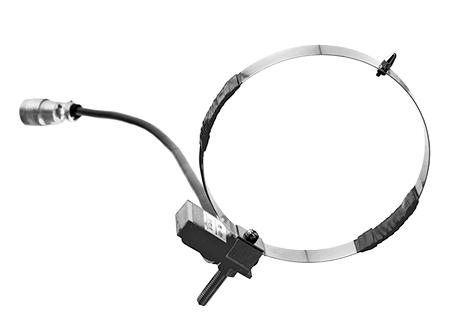
- Features
- High Response
- Stable measurement with simple shape
- Easy handling
-
Specifications
Type Capacity Rated output Sensitivity
(x 10-6 strain/mm)Non-linearity Temperature range OU-10 10mm Approx. 5mV/V
(10000 x 10-6 strain)Approx. 1000 1%RO 0 to +40℃ OU-20 20mm Approx. 500 OU-30 30mm approx. 300 Output polarity
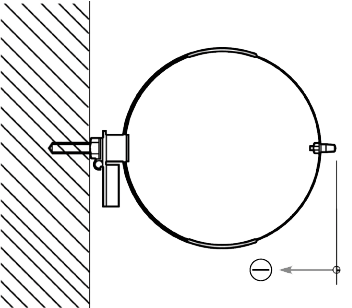
Measurement moves in the minus direction when the contact tip is pushed inward.
More Information
Strain gauge Users' Guide
Temperature Gauge
Strain gauge Users' Guide
Strain gauge Users' Guide
Strain Gauge Performance Characteristics
A wide range of TML strain gauges are available to match diverse measuring conditions. Since strain gauges provide their designed functions only when they are attached to specimens, it is important to select the most appropriate gauge type in consideration of the specimen material type, gauge type in consideration of the specimen material type, operating temperature, measurement environment and installation dimensions. The Strain Gauge Users' Guide provide inexperience users with comprehensive information on strain gauges, covering various subjects ranging from step-by-step strain gauge installation instructions to cautions in handling strain gauges. The Strain Gauge Performance Characteristics compile a guide to the technology of current strain gauge for use in consideration of a limit in detection with regard to the materials and size of a test specimen, humidity, the amount of strain, speed, fatigue, environments, etc..

Spot Welder
Flange Mounting-type Torque Transducer
LTB-NA Torque Transducer 10N・m to 1kN・m
The LTB-NA Torque Transducer is a flange-mounted transducer that is installed between non-rotating measuring items in order to detect torque in the items.
Protection ratings : IP 30 equivalent
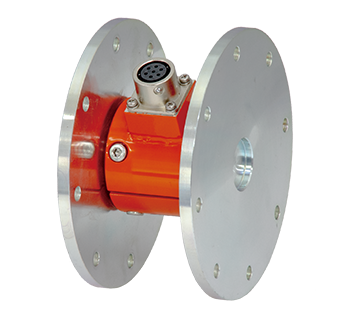
- Features
- Measurable without the effect of bending
- Easy installation with flanges
-
Specifications
Type Capacity Rated output Non-linearity Temperature
rangeLTB-10NA 10N・m 1mV/V
(2000x10-6strain)±2%0.3%RO -10 to +60℃ LTB-20NA 20N・m LTB-30NA 30N・m LTB-50NA 50N・m LTB-100NA 100N・m LTB-200NA 200N・m LTB-300NA 300N・m LTB-500NA 500N・m LTB-1KNA 1kN・m
More Information
Spot Welder
SPOT WELDER W-50RC
This is a capacitive charge spot welder used for installing weldable strain gauges and fixing lead wires. The welding energy is controlled in 2 ranges of 1~10/5~50 watt second continuously, and a stabilizing circuit cancels the effect of changes in the power source voltage. Projecting parts such as electrical cables is packed inside, it is extremely convenient for field applications.
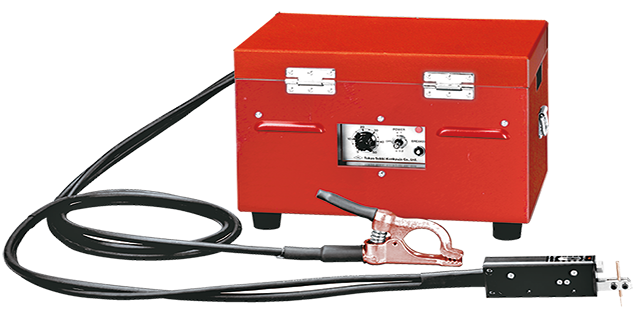
| Dimensions | 300(W)x195(H)x195(D)mm |
|---|---|
| Weight | 13kgs. |
| Power source | 90 to 110V ac |
| Welding energy | 1 to 10 watt sec./5 to 50 watt sec. continuous 60 watt sec. Max. (110V ac. 50Hz) |
| Output voltage | Approx. 32V Max. |
| Output pulse width | Approx. 5 msec. |
| Repetion use | 2 welds/sec. at 50 watt sec. |
More Information
Temperature Gauge
TF series Temperature gauge
These gauges are bonded on the specimen surface like ordinary strain gauges, and measures the surface temperature. By combining with the dedicated temperature gauge adaptor (TGA), actual temperature can be measured easily using a strainmeter.
| Applicable specimen | General |
|---|---|
| Operational temperature | -20 to +200°C |
| Temperature compensation range | - |
| Applicable adhesive | NP-50B, CN, C-1 |
| Backing | Polyimide |
| Element | Ni alloy |
| Strain limit | - |
| Fatigue life at room temperature | - |
-
TEMPERATURE GAUGE
Gauge pattern Type Gauge length
(mm)Gauge width
(mm)Backing length
(mm)Backing
width (mm)Resistance (Ω) Sensitivity (Ω/℃) 
TFL-2-60 2 1.9 6.1 3.5 60 0.34 approx. TFL-3-60 3 3.2 8.5 5 60 0.34 approx. TFL-6-60 6 2.6 12.4 4.5 60 0.34 approx. TFL-8 8 3.5 14 5.5 120 0.68 approx. Leadwire-integral service is available on request.
-
TGA-1A/TGA-1B Temperature Gauge Adaptor Optional
This adaptor is provided with temperature gauge TF series for direct reading of temperature with optional strainmeter, and converts output to 100×10-6 strain/℃.
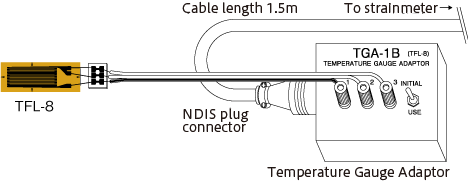
Type of Adaptor Type Temperature (℃) Sensitivity (x10-6 strain/℃) Accuracy (℃) Bridge mode Dimensions (W)
x (H)
x (D)Weight (g) TGA-1A TFL-2-60 -20 to +200 100 ±1,or less Full bridge 100 x 40 x 70 370 TFL-3-60 TFL-6-60 TGA-1B TFL-8
More Information
Waterproof strain gauge
WF series Waterproof strain gauge
This is WF-series water proof type strain gauge having a pre-attached vinyl lead wire and an entire coating with epoxy resin. The coating is transparent and flexible, which ensures easy installation of the gauge.
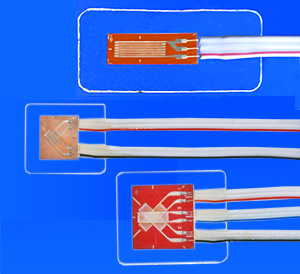
| Applicable specimen | Metal, Glass, Ceramics |
|---|---|
| Operational temperature(℃) | 0 to +80℃ |
| Temperature compensation range(℃) | +10 to +80℃ |
| Applicable adhesive | CN, P-2 |
| Backing | Epoxy |
| Element | Cu-Ni |
| Strain limit | 3% (30000 x 10-6 strain) |
| Fatigue life at room temperature | 3 x 104 (±1500 x 10-6 strain) |
-
Single-element (G.F. 2.1 approx.)
0.08mm2 integral vinyl leadwire Total leadwire resistance per meter : 0.44Ω

Type Gauge Backing Resist-ance
(Ω)Lead wire pre-attached Type name of lead wire preattached length
(mm)width
(mm)length
(mm)width
(mm)thickness
(mm)WFLA-3-11
WFLA-3-17
WFLA-3-233 1.7 17 8 1.5 120 Paralleled 1m
Paralleled 3m
Paralleled 5m
3-wire 3m
3-wire 5m-1LDBB
-3LDBB
-5LDBB
-3LDBTB
-5LDBTBWFLA-3-350-11
WFLA-3-350-17
WFLA-3-350-233 3.2 17 8 1.5 350 Paralleled 1m
Paralleled 3m
Paralleled 5m-1LDBB
-3LDBB
-5LDBBWFLA-6-11
WFLA-6-17
WFLA-6-236 2.2 25 11 1.5 120 Paralleled 1m
Paralleled 3m
Paralleled 5m
3-wire 3m
3-wire 5m-1LDBB
-3LDBB
-5LDBB
-3LDBTB
-5LDBTBEach package contains 10 gauges.
-
90° 2-element Rosette Stacked type(G.F. 2.1 approx.)
0.08mm2 integral vinyl leadwire Total leadwire resistance per meter : 0.44Ω
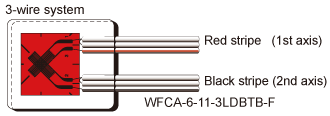
Type Gauge Backing Resist-ance
(Ω)Lead wire pre-attached Type name of lead wire preattached length
(mm)width
(mm)length
(mm)width
(mm)thickness
(mm)WFCA-3-11
WFCA-3-17
WFCA-3-233 1.7 19 16 1.5 120 Paralleled 1m
Paralleled 3m
Paralleled 5m
3-wire 3m
-wire 5m-1LDBB
-3LDBB
-5LDBB
-3LDBTB
-5LDBTBWFCA-6-11
WFCA-6-17
WFCA-6-236 2.3 25 21 1.5 120 Paralleled 1m
Paralleled 3m
Paralleled 5m
3-wire 3m
3-wire 5m-1LDBB
-3LDBB
-5LDBB
-3LDBTB
-5LDBTBEach package contains 10 gauges.
-
45°/90°3-element Rosette Stacked type (G.F. 2.1 approx.)
0.08mm2 integral vinyl leadwire Total leadwire resistance per meter : 0.44Ω
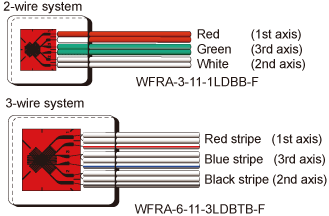
Type Gauge Backing Resist-ance
(Ω)Lead wire pre-attached Type name of lead wire preattached length
(mm)width
(mm)length
(mm)width
(mm)thickness
(mm)WFRA-3-11
WFRA-3-17
WFRA-3-233 1.7 19 16 1.5 120 Paralleled 1m
Paralleled 3m
Paralleled 5m
3-wire 3m
3-wire 5m-1LDBB
-3LDBB
-5LDBB
-3LDBTB
-5LDBTBWFRA-6-11
WFRA-6-17
WFRA-6-236 2.3 25 21 1.5 120 Paralleled 1m
Paralleled 3m
Paralleled 5m
3-wire 3m
3-wire 5m-1LDBB
-3LDBB
-5LDBB
-3LDBTB
-5LDBTBEach package contains 10 gauges.
More Information


